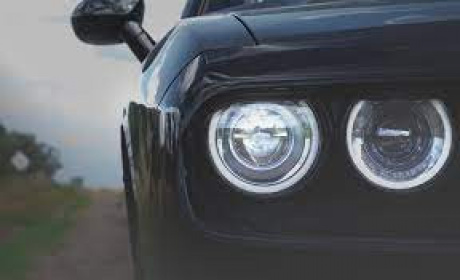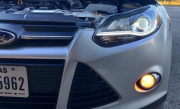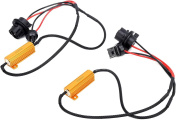
Headlights for your vehicle are important because they enable you to see at night and in bad weather. They also help you be seen by other drivers, which is especially important when driving on busy roads. Today, many vehicles are equipped with LED headlights. So how do LED headlights work?
What is LED technology?

LED stands for light-emitting diode. LEDs are small, efficient light sources that are increasingly being used in a variety of applications, including vehicle headlights.
This light technology was invented in 1907 by British engineer H. J. Round. However, it was not until the 1960s that LEDs began to be used commercially. In recent years, the use of LEDs has exploded due to their many advantages over traditional incandescent light bulbs, including lower energy consumption, longer lifespan, and faster switching time.
LEDs don't waste energy in the form of non-light-producing heat because they employ "cold" light generation technology, in which most of the energy is delivered in the visible spectrum. You can think of an LED as a tiny light bulb. In fact, they are often used as indicator lights on electronic devices.
Here are the benefits of using light-emitting diode headlights in your vehicle:
- LEDs are more energy-efficient than traditional incandescent bulbs and can last up to 50,000 hours.
- They emit a bright, white light that is closer to natural sunlight than the yellowish light of incandescent bulbs, making it easier to see at night.
- LED headlights respond faster than incandescent headlights, which means they can help you avoid potential accidents.
- They are more durable than traditional bulbs and can withstand vibration and shock without breaking.
- Since they don't produce as much heat as incandescent bulbs, LED headlights stay cooler, which reduces the risk of melting snow or ice on your windshield.
If you're looking for a more energy-efficient and longer-lasting option for your vehicle's headlights, LED lights are a great choice. Keep in mind, however, that they may cost more upfront than traditional bulbs. But with proper care, LED headlights can last you many years to come.
How do LED headlights work?
Unlike incandescent bulbs, LEDs don't have a filament that needs to be heated in order to produce light. Instead, electricity is passed through a semiconductor material, which emits photons (light particles).
The semiconductor material used in LEDs is usually made of carbon, nitrogen, and/or phosphorus. When electricity is applied to the semiconductor material, it becomes energized and releases photons. The photons then travel through the semiconductor material until they reach the lens of the LED, where they are emitted as visible light. The color of the light produced by an LED depends on the type of semiconductor material used. For example, blue and white LEDs are made of different materials than red and yellow LEDs.
The major advantage of LEDs over traditional incandescent bulbs is that they are much more energy-efficient. This is because traditional incandescent bulbs produce light by heating a filament until it becomes white-hot. But this process is very inefficient because only about 10% of the electricity used is converted into visible light, while the rest is wasted as heat.
LEDs, on the other hand, produce light through a process called electroluminescence, which is much more efficient. In fact, LEDs can convert up to 80% of the electricity they use into visible light. This makes them much more energy-efficient than traditional incandescent bulbs.

Another advantage of LEDs is that they have a much longer lifespan than traditional incandescent bulbs. In fact, LEDs can last up to 50,000 hours, while incandescent bulbs typically only last for 1,000 hours. This means that you won't have to replace your LED headlights as often as you would traditional bulbs.
LEDs also respond faster than traditional incandescent bulbs, which means they can help you avoid potential accidents. And since they don't produce as much heat as incandescent bulbs, LED headlights to stay cooler, which reduces the risk of melting snow or ice on your windshield.
Do LEDs work in cold weather?
The benefits of LED headlights are that they don't produce or need heat to function, meaning they work best in cold weather. The downside is that snow can stick to them and potentially obscure the driver's view. Also, some LEDs have been known to suffer from "polarity reversal," where the positive and negative wires are reversed, causing the light to flicker or not work at all.
To prevent these issues, it's important to make sure your LED headlights are properly installed and that the wires are connected correctly. You should also regularly clean your headlights to remove any build-up of snow or ice.
LED headlights offer many benefits over traditional incandescent bulbs, including improved energy efficiency, longer lifespan, faster response time, and greater durability. However, they may cost more upfront than traditional bulbs. But with proper care, LED headlights can last you many years to come.
What are adaptive LED lights?
Have you ever heard of adaptive LED headlights? These are a type of LED headlight that automatically adjust the beam pattern to provide the best possible visibility, regardless of the conditions.
For example, if you're driving on a winding road at night, the adaptive LED headlights will change the beam pattern to provide more light around the turn. Or if you're driving in heavy rain or snow, the adaptive LED headlights will change the beam pattern to help you see better through the weather.
Adaptive LED headlights are a great option for anyone who wants the best possible visibility while driving. And since they automatically adjust to changing conditions, they're also very convenient. If you're looking for an energy-efficient and long-lasting option for your vehicle's headlights, LED lights are a great choice. And if you want the best possible visibility while driving, adaptive LED headlights are the way to go.
Can you put LED bulbs in regular headlights?
Oftentimes, drivers are disheartened by their dim halogen headlights and subsequently ask us: “Can I upgrade to LED or HID bulbs?” Fortunately, the answer is yes. The truth is that when replacing the light bulb for your headlights, it is usually just a matter of finding the right model that will fit into your car. It is possible to find an LED or HID replacement for nearly every halogen headlight bulb on the market.

However, we do not recommend simply swapping out your old bulbs for new ones without doing some research first. Depending on your car, you might need to make some adjustments to ensure that your new LEDs or HIDs are compatible with your headlight housing and won’t cause any damage.
If you have ever wondered how those bright, white headlights get their start, then read on. We’ll give you a quick rundown of how LEDs and HIDs work and dispel some common myths about these popular upgrades.
Is LED technology better than halogen or xenon?
Usually, when we talk about headlight bulbs, we’re really talking about the filaments inside them. That’s because most bulbs on the market today use halogen or xenon gas to help light up the filament. LED (light emitting diode) technology is different in that it doesn’t require a filament at all.
Halogen bulbs are the most common type of headlight on the market. They are filled with halogen gas and use a tungsten filament. When electricity is applied to the filament, it gets hot and starts to glow. The halogen gas helps to keep the filament from burning out too quickly.
Xenon bulbs are similar to halogen bulbs in that they also use a tungsten filament. However, they are filled with xenon gas instead of halogen gas. Xenon bulbs produce more light than halogen bulbs but require less electricity to do so.
When electricity is applied to the silicon, it produces light. LEDs are much more energy-efficient than halogen or xenon bulbs because they don’t use a filament that needs to be heated in order to produce light. One of the benefits of LED technology is that it can be used to create very bright, white light. This is why LEDs are often used in car headlights. Another benefit of LED technology is that it is very energy-efficient. In fact, some estimates suggest that LED bulbs can be up to 90% more energy-efficient than traditional incandescent bulbs.
Are LED headlights efficient?
Yes, LED headlights are very efficient. In fact, they are up to 90% more energy-efficient than traditional incandescent bulbs. This means that you can get the same amount of light from an LED bulb using less electricity.
LED headlights last a lot longer than traditional incandescent bulbs. This means that you won't have to replace your headlights as often, which is good for the environment. What's more, LED bulbs contain no toxic materials. So when you do eventually dispose of them, they won't harm the environment. Besides, LED bulbs are made from recycled materials, so they are also good for the environment.
To select the most efficient bulb for your headlights, you have to consider the following factors:
- The type of vehicle you have
- The size of your vehicle's engine
- Your driving habits
If you have a large engine and drive long distances regularly, then an LED bulb is probably the best option for you. However, if you have a small engine and only drive short distances occasionally, then a traditional incandescent bulb might be a better option for you. Ultimately, it all comes down to personal preference. Whichever option you choose, just make sure that you get the most efficient bulbs for your car!

Bottom line
Overall, LED headlights are a great option if you are looking for a more efficient and environmentally-friendly option. However, before you make the switch, be sure to do your research to ensure that you get the most compatible and efficient bulbs for your car! LED headlights are a great option if you are looking for a brighter, more energy-efficient light. If you have ever wondered how those bright, white headlights get their start, then read on.








